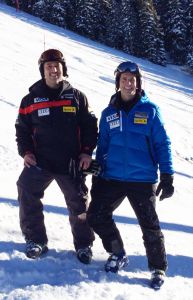It’s that time of year again. Whether you make occasional weekend trips to the mountains or spend every weekend watching your children race, skiing and snowboarding are a part of winter in New England. Both activities can be great exercise and a lot of fun, but nothing can ruin a family vacation to the mountains like a skiing or snowboarding injury. It’s important to take the proper precautions and understand the risks to help ensure that everyone stays healthy all winter long.
According to the American Orthopaedic Society for Sports Medicine, most snow sport injuries are traumatic. They usually result from a fall or collision with an object or skiing on challenging terrain. What we don’t always think about before we hit the slopes is whether or not our body is ready for the focus and endurance that snow sports require. Here are the most common factors that can lead to skiing or snowboarding injuries:
- Length of time skiing or snowboarding without rest
- Skiing on terrain more challenging than ability level
- Improper fitting or faulty equipment
- Altitude sickness or improper adjustment to change in altitude
- Dehydration or fatigue
- Skiing or snowboarding off-trail or out of bounds
- Failure to follow warning signs or mountain responsibility codes
 All of the variables above can lead to injury. At the end of a long day, our bodies can become fatigued and lose strength or control which help maintain proper form. The mountain conditions also tend to deteriorate throughout the day and snow and ice can create hazards. The combination of fatigue and poor conditions can lead to devastating injuries. At one time or another, many have borrowed older or poorly fitting equipment to save a few bucks. Ski bindings are designed to release based on experience, body weight and the likelihood of impact, and if they are not adjusted properly, a skier can be more vulnerable to injury during a fall. Ill-fitting snowboarding boots or bindings also create unbalanced forces on the knee or lower leg and can result in traumatic injury.
All of the variables above can lead to injury. At the end of a long day, our bodies can become fatigued and lose strength or control which help maintain proper form. The mountain conditions also tend to deteriorate throughout the day and snow and ice can create hazards. The combination of fatigue and poor conditions can lead to devastating injuries. At one time or another, many have borrowed older or poorly fitting equipment to save a few bucks. Ski bindings are designed to release based on experience, body weight and the likelihood of impact, and if they are not adjusted properly, a skier can be more vulnerable to injury during a fall. Ill-fitting snowboarding boots or bindings also create unbalanced forces on the knee or lower leg and can result in traumatic injury.
Skiing or snowboarding often requires a trip to a higher altitude environment. Living close to sea-level, our bodies can require time to adjust to high-altitude conditions. This may lead to fatigue, nausea, dizziness or muscle weakness. And finally, many of us have been tempted to “duck a rope” or explore the back-country beyond the boundaries of a ski area. While finding fresh powder might be fun, boundaries are there for a reason and the conditions and terrain can be hazardous and unpredictable in these areas.
The most common traumatic injuries associated with skiing and snowboarding are ACL injuries of the knee, shoulder dislocations or fractures, lower extremity fractures, spinal injuries, head injuries and wrist, hand or thumb injuries. Thankfully, most snow sport injuries are minor strains and sprains or bumps and bruises. However, more serious injuries are possible and can be catastrophic, resulting in a lengthy recovery.
So how do we prevent injuries? Most importantly, try to avoid the risk factors listed above. But proper strength and conditioning can reduce the risk of injury. Working out our legs and muscles that protect our joints and tendons can help insulate them from injury. Consider following a training program before the ski season to help isolate the muscles that are more commonly used in snow sports. Proper instruction and technique can reduce the risk of injury, and always make sure to ski or ride on terrain or at a pace that you are comfortable with. Make sure your gear fits and has been adjusted properly for your body size and skill type. Helmet use, while still not required at most ski areas, can significantly reduce the risk of more serious head injuries. Helmets have been shown to reduce head, neck and face injuries by 43% according to the AOSSM. And finally, parents should help educate their children about the skier’s code of conduct and the risks associated with snow sports.

Skiing and snowboarding are a lot of fun and a great way to get outdoors and stay active during the winter. Parents should always educate their children about the code of conduct on the mountain and the risks associated with snow sports. Follow these easy tips and use common sense to stay injury-free and have a fantastic time.
A. David Davis, MD is an orthopaedic surgeon at Access Sports Medicine & Orthopaedics. He is fellowship-trained in sports medicine and arthroscopy at the New England Baptist Hospital in Boston. Dr. Davis specializes in the treatment of shoulder, knee and hip injuries.

